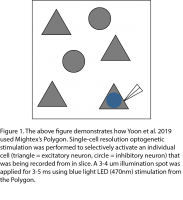Working memory enables us to both temporarily hold information in our minds for further cognitive processing and direct future behaviour. Previous studies in rodents demonstrate that subsets of neurons in the prefrontal cortex that are active during a cue remain active in the delay period, even in the absence of the cue(1). Spiking patterns during this delay period display high variability, leading to the suggestion that brain activity during this delay consists of network activity, rather than the contribution of individual neurons(2).
One potential player in modulation of this network activity is different forms of short-term synaptic plasticity (STP) in the prefrontal cortex. To date there has not been a comprehensive study of STP between the neuron subtypes in the prefrontal cortex, and these neurons may contribute to the persistent activity that is displayed in working memory tasks.
Recently published in Cerebral Cortex, Yoon et al. 2019 performed an in-depth exploration of the intricate interactions between various neuron subtypes in the prefrontal cortex using electrophysiology, optogenetics, and network modeling. These experiments aimed to uncover the link between network activity in the prefrontal cortex and the persistent activity seen during the delay period of a working memory task.
To study STP in the prefrontal cortex, Yoon et al. 2019 used Mightex’s Polygon pattern illuminator to restrict the illumination area for optogenetic stimulation of ChIEF (470nm). By using the Polygon, the authors were able to illuminate an individual cell (3-5 um illumination spot) for optogenetic stimulation, to eliminate the effects of off-target activation, and record neuron activity (see Figure 1).
Yoon et al. 2019 demonstrated that excitatory and inhibitory neurons in the prefrontal cortex displayed a combination of short-term potentiation and depression, when interacting with other neurons in the prefrontal cortex. By modeling the interaction between short-term potentiation and depression that was displayed by these neurons, this appeared to maintain persistent activity, suggesting that the network activity may contribute to the persistent activity in the working memory delay.
This is one of the first comprehensive studies of STP in the prefrontal cortex between different neuron subtypes. Similar to previous studies, the use of optogenetics provided comparable STP results in the prefrontal cortex. The authors suggest that this model is far from complete, and can be much more complex with the integration of various neurotransmitter systems.
To learn more about the Polygon, click here. Or, read our white paper comparing tools for neuroscience optogenetics.
To read the full paper published in Cerebral Cortex, click here.
Yoon, J.Y., Lee, R.H., Ho, W.K., & Lee, S.H. (2019). Disparities in Short-Term Depression Among Prefrontal Cortex Synapses Sustain Persistent Activity in a Balanced Network. Cerebral Cortex.
References
(1)Fujiawa, S. et al. (2008). Behavior-dependent short-term assembly dynamics in the medial prefrontal cortex. Nature Neuroscience, 11(7).
(2)Compte, A. et al. (2003). Temporally irregular mnemonic persistent activity in prefrontal neurons of monkeys during a delayed response task. Journal of Neurophysiology, 905(5).



